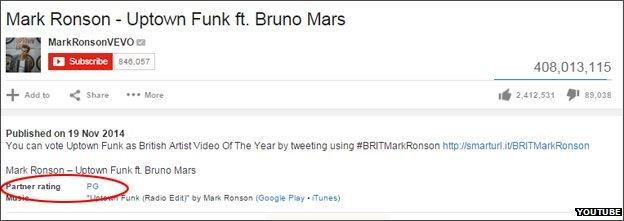Online music videos get age ratings
- Published

Mark Ronson and Bruno Mars's video for Uptown Funk received a PG rating
Fans watching music videos on YouTube and Vevo will be presented with cinema-style age certificates from Thursday.
The age ratings are part of a government-backed pilot scheme, which aims to protect children from unsuitable content.
It follows concerns over explicit videos by artists including Miley Cyrus, Robin Thicke and Rihanna.
Ratings will be decided by the British Board of Film Classification, with all three major record labels taking part.
This is the second phase of the pilot, which began as a behind-the-scenes trial in October.
It currently only applies to British acts signed to Sony, Universal and Warners, who have been submitting their videos to the BBFC for consideration.
The initial phase found that roughly 20% of all videos would receive a 12, 15 or 18 certificate.
However, labels were not required to submit videos they felt would not attract a rating.
Among the songs deemed to require certification were Ellie Goulding's Love Me Like You Do - from the soundtrack to Fifty Shades of Grey. The video, which contained several excerpts from the erotic thriller, was rated 15 by the BBFC for "strong sex references".
Other examples included:
Kasabian - Stevie Released last October, the unsettling video for Stevie showed a young boy being raised as a test subject in a laboratory. It received a 12 certificate for "moderate threat".
Dizzee Rascal - Couple of Stacks The video for Dizzee Rascal's last single was graphic enough to earn an 18 rating. The BBFC cited the video's "strong bloody violence, gore [and] very strong language" in its ruling.
Prides - I Should Know You Better Shot in Scotland, the video for Prides' synthpop single featured a "weird and sad tale of a nice yeti just trying to get along in life" until a hunter cuts his life short. It was rated 12 for "moderate threat, violence and sexual images."
During the first phase of the trial, 84 music videos were given a certification. Of those, 27 were rated 12; 39 were rated 15; and only one was rated 18.
Six music videos submitted to the BBFC were classified U and 11 were classified PG.
Once given an age rating, record labels pass on the guidance to the two digital service providers - Vevo and YouTube - who, in turn, display it when the videos are broadcast online.
At the moment, there is no rule on how the guidance should be displayed.
YouTube's current format is to list the information in plain text under the video.

Unlike a film or DVD, the rating information is not contained in a title card at the beginning of the video
However, guidance on how to impart the information may be imposed once the pilot ends later this year.
The results will be evaluated based on consumer research, when consideration will also be given to how the scheme can be applied more widely.
Vevo's Nic Jones said it was unlikely to include the implementation of an "age gate", locking out younger viewers.
"At the moment there isn't a plan to restrict access," he told the BBC.
"The aim isn't to make it harder to view music videos," he continued. "We want to give information to the public so that they can make a choice on viewing material based on that information."
Criticism
The pilot scheme was announced by prime minister David Cameron in a speech on families, external last August.
It came after parents and musicians spoke out about the content of music videos.
Pop star Annie Lennox was among those who called the imagery of certain videos "dark" and "pornographic".
"I'm all for freedom of expression," she told the BBC, "but this is clearly one step beyond, and it's clearly into the realm of porn."
As the trial scheme goes public, David Austin, assistant director of the BBFC said: "We hope this pilot will provide consumers with information to help guide them and their families when accessing music videos online.
"Parents taking part in our most recent review of the BBFC Classification Guidelines in 2013, expressed their concerns about the content of music videos online, in particular their role in the sexualisation of girls and portrayals of self-harm, drug use and violence in some music video content."
YouTube's Candice Morrissey added: "Over the last few months, we have been working with the UK's music industry to help them display the BBFC's age ratings on their music videos on YouTube.
"These are in addition to the controls we already provide on YouTube including the ability for uploaders to add age warnings to videos and a safety mode to help parents screen out content they do not feel is suitable for their children."
- Published7 October 2013
